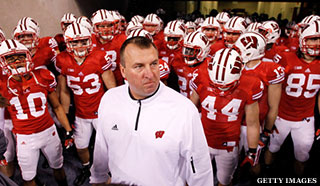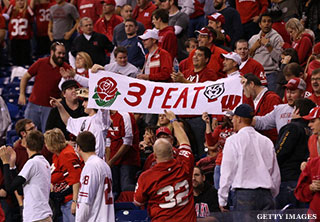The move by Wisconsin football coach Bret Bielema to accept a higher paying job for himself and his assistants at Arkansas weeks before his old team is slated to play in the Rose Bowl raises the perpetual question: Are massive football and basketball salaries for coaches at institutions of higher learning justified?
Bielema will be paid a base salary of $3.2 million a year for a guaranteed six years with incentives that can push his revenue to roughly $4 million per year. If Arkansas were to fire Bielema in the first three years, they would owe him $12.8 million. His assistants also received hefty raises. When Tennessee fired Derek Dooley last month, the Vols obligated themselves to pay him $5 million in monthly installments.

Six years ago, 42 major college football coaches made at least $1 million per year. Today 42 coaches make at least $2 million. The average annual salary for head coaches at major colleges is $1.64 million, up nearly 12 percent over last season -- and more than 70 percent since 2006, according to USA Today.
Head football coaches like Nick Saban of Alabama and Mack Brown of Texas make $5.5 million and $5.3 million, respectively. The assistant football coaches at Clemson share a compensation pool of $4.2 million -- do the math. According to Esquilar, an executive compensation data firm, between 2007 and 2011, CEO pay including salary, stock, options, bonuses and other compensation, rose 23 percent. In that same time period coaches' pay increased 44 percent.
This massive explosion of spending on coach's compensation is occurring against the backdrop of funding crises at universities across the nation. The economic recession has dropped alumni giving levels and public universities have had tax funding reduced. This has caused a decline in instructional spending, and resources and dramatic increases in tuition. Compensation for university presidents is under attack; they average $421,000. Athletic director salaries average about $450,000. These figures are dwarfed by the revenue generating athletic coaches. So under what rationale are these coaches compensated?
There is no figure with as dynamic an impact on the success or failure of a college athletic program than the coaching staff. Unlike professional sports and high schools, they have to recruit every athlete who plays for them. This is a Social Darwinian cutthroat competition. The pressure to recruit is year-round and inescapable.
They have to project the growth rate and maturation of 17-year-olds over the next four years. Guessing correctly is part of what makes the difference in roster strength. Coaches are then charged with supervising the nutrition, weight training, behavior, academic prowess and practice of older adolescents who are often still in a growth and maturity phase. The players are not being paid and need constant motivation and mentoring.
These same coaches face constant external pressure and second guessing from athletic directors, parents, administrators, boosters, the public, and the press. To gracefully perform all these functions and produce a perpetually winning team is an extraordinary achievement. When attendance drops, the college coach is the first blamed.

Most alumni sustain a large part of their interest in their alma mater's through following the progress of the school's men's basketball and football programs. It binds and unifies alums. I have talked with university presidents who indicate that they feel that 50 percent of alumni gifts to their schools may be triggered by athletic interest. The gift may be given to the music department rather than athletics, but it is spurred by athletic achievement and the pride it engenders. This giving plays a crucial role in university funding. Revenue also flows from the sale of memorabilia and merchandising with school logos. And clearly, monies generated by successful football and basketball programs can subsidize less profitable men's and women's sports that provide valuable experiences for other student athletes.
It is the explosion in television revenue that is altering college athletics. The network packages for football conference rights fees are rising exponentially. The new deal the Pac-12 signed with ESPN and Fox totals $3 billion over 12 years. This eclipses the previous deal. The Conferences are operating or starting their own television networks, adding to the bonanza. The success of an individual team can lead to a richer cornucopia. Those teams that have unique following and brand, like Notre Dame, can do their own network deals. The University of Texas has created its own Longhorn Network. And college athletics is availing itself of internet opportunities as well as tablet and mobile phones.
No factor is more important to insuring a winning collegiate sports program than the vision, system, development techniques and coaching provided by its coaches. Nothing is more important to television and other revenue streams for universities than creating a winning and distinctive brand. No achievement by a university stimulates more critical alumni giving than a winning sports program. The decision as to whether operating such a program in pressure-packed Division I sports fits with a universities' other values and priorities is the prerogative of each institution to make. But if the school makes the decision to compete, no money is better spent than that to secure the most productive coaching staff.
-- Leigh Steinberg has represented many of the most successful athletes and coaches in football, basketball, baseball, hockey, boxing and golf, including the first overall pick in the NFL draft an unprecedented eight times, among more than 60 first-round selections. His clients have included Hall of Fame quarterbacks Steve Young, Troy Aikman and Warren Moon, and he served as the inspiration for the movie "Jerry Maguire." Follow him on Twitter @SteinbergSports.




